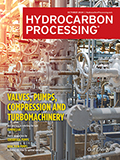
October 2024
Special Focus: Valves, Pumps, Compression and Turbomachinery
This article discusses the best practices for selecting compressors for different applications in refining, petrochemical, chemical and carbon capture plants.
Bearings are valuable components that support the proper functionality of pumps. However, like any essential component, they require adequate protection. The best technology to guard against premature bearing failure is bearing isolators, and it is critical to select the correct bearing isolator design that incorporates features specific for oil mist lubrication.
This article provides a thorough analysis of various warm-up practices—examining their benefits and drawbacks and proposing well-grounded guidelines for the development of efficient warm-up systems.
Vibration of axial flow pumps has emerged as a key problem to the long-term, reliable and stable operation of these pumps in the chemical industry. This article dives into this issue and provides analysis and remedy.
Process Optimization
Traces of particulate mercury sulfide (HgS) in stabilized crude oils transform to elemental mercury below 400°C in refinery distillation units. The authors evaluated this transformation and measured reaction rates and activation energies in crude oil and Hg-spiked mineral oil, using glass vessels at atmospheric pressure and a microunit at 1,000 psig.
Refining Technologies
This article looks at the global graphite market and future demand. In turn, it details the author's company's proven delayed coking technology through conventional and two-step processes to produce carbon precursors for synthetic graphite and needle coke for graphite electrodes.
Prompt engineering elaborates precise instructions to guide large language models towards generating specific, desired outputs, and offers significant potential for optimizing processes, solving complex problems and improving operational efficiency in refineries and petrochemical plants. In Part 2, the practical applications of these advanced prompt engineering techniques in various aspects of refinery operations will be explored. Examples include key areas where RAG implementation with specific plant information would be highly beneficial.
Maintenance, Reliability and Inspection
This article delves into the effects of providing standard design temperature allowances for piping systems operating in the creep range. The aim of examining this practice is to enhance the understanding of its implications for pipe engineering.
This article presents a review of a failure that happened in a hairpin heat exchanger type on the shell side in a hydrogen (H2) reformer unit. This mechanism was not identified during the design phase and led to a failure after only two years of operation. This article also reviews the situations encountered during the design stage and how they affected the material selection.
Digital Technologies
With the aim to maximize profit, and contribute to sustainability targets by reducing greenhouse gas emissions, ADNOC Sour Gas has optimized condensate hydrotreater operation by adjusting Reid vapor pressure, which resulted in maximizing condensate yield. This article is a case study on using a process digital twin to optimize condensate yield.
From the foundations of measuring emissions in real time, to forecasting the impact of each lever and automating reporting, digital technologies help processors track key sustainability metrics and overall progress in the journey to net-zero.
Water Management
A very important—and sometimes overlooked—unit operation within hydrocarbon processing facilities is makeup water treatment for steam generators and other processes. Many cases have been documented in which makeup system upsets have led to boiler tube failures that partially or completely shut down unit processes. The three parts of this article (August, September and October 2024) serve as a guide for those employees who may be on a steep learning curve when it comes to makeup system understanding.
Hydrogen
Several countries and multinational corporates have adopted a strong commitment to the targeted achievement of net-zero emissions and have taken up green H2 and ammonia projects, including hubs for domestic distribution and export. This article will analyze how such H2 hubs can be planned, executed and operated.
Trends and Resources

- Phillips 66 Limited agrees to acquire Lindsey Oil Refinery assets 1/5
- IIT Guwahati (India) develops sunlight-driven catalyst to convert carbon dioxide into methanol fuel 1/5
- PBF Energy provided an update on efforts to rebuild its Martinez refinery 1/5
- C2X to deliver 3.6 MM metric tons of carbon removal to Microsoft over 12 yrs 1/5
- Tasnee's Saudi Ethylene and Polyethylene Co. commences planned maintenance of ethylene plant 1/2
- Advanced Biofuels Canada Association welcomes federal biofuels production incentive coming into force 1/2




